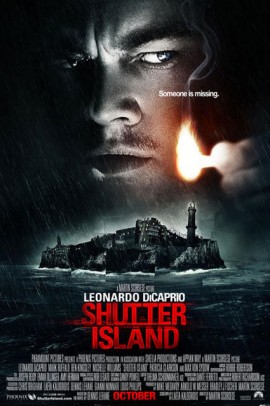Shutter Island (2010)
Synopsis
Drama set in 1954, U.S. Marshal Teddy Daniels is investigating the disappearance of a murderess who escaped from a hospital for the criminally insane and is presumed to be hiding nearby. This movie has an amazing twist at the heart of it and you may wish to watch it BEFORE reading this. However, you will want to watch it again.

| Genre | Thriller |
| Production year | 2010 |
| Director | Martin Scorsese |
| Male actors | Leonardo DiCaprio, Mark Ruffalo, Ben Kingsley |
Denial is Not a River in Egypt
by Paul Miller
Past Traumas
Teddy Daniels – the US Marshall – is a troubled man who has returned from WWII having seen the horrors of the holocaust in the Nazi death camps. Pierre Janet (30 May 1859 – 24 February 1947) IMHO the true father of psychotherapy coined the words ‘dissociation’ and ‘subconscious’. He stated that traumatic memories were stored differently in the brain to normal memories and this is now been proven with modern scanning techniques.
Essentially traumatic memories are relived rather than re-experienced. He was one of the first people to draw a connection between events in the subject’s past life and his or her present day trauma. This is what we see Teddy experiencing in the movie. His past memories invade his present reality and impair his judgement and functioning. As men we need to ‘swallow our shadows’ – this means we acknowledge that there are unknown things in our subconscious, dissociated from our everyday mind that we need to bring into the light so they can be examined and eventually challenged.
Otherwise like Teddy in the movie every German is a Nazi… so when the German psychiatrist tells him that in Greek the word ‘trauma’ means ‘wound’ and then tells him “when you see a monster you must stop it”; instead of stopping the monster within his own mind he projects that monster onto the doctor and injects him; sedating him. How often do we numb ourselves against the truth of our own monsters?
Who to Believe?! Stay in Ward C or go to the Lighthouse?
Teddy is an investigator – a US Marshall – and he is trying to gather the facts that he needs and then stitch them together into a meaningful narrative. This is what our mind does every day we take the raw data of our own experiences and build a narrative connecting our past-present-future. Yet his own thoughts are generating stories that confuse him as he seeks a solution to his investigation.
Even when the prisoner – who holds an archetypal hermit energy – confronts him with the truth in Ward C saying, “All of this is for you. You’re a rat in a maze!” Terry is unable to accept it. The hallucination of his late wife warns him that going into the lighthouse will be ‘the end’ of him. Unless we are examining our lives and consider that some unpalatable things may be true then we will remain in denial and the things we need to examine and confront remain in shadow. Just like the darkness of Ward C in the film: a place of lies, suffering and pain.
“Who is 67?”
As Teddy investigates the missing female prisoner/patient he examines her cell & finds a scrap of paper with a few lines, one of which asks, “who is 67?” This represents the question we must all ask – who am I? – and we are invited to ask this in a place of wisdom too. Wisdom is often represented as the feminine in myths and it is feminine characters that speak the truth to the US-Marshall throughout, but although he hears them he does not listen to what they are telling him. Who patient 67 is; is the most important question in the entire movie.
– SPOILER WARNING – The Twist
His own thoughts tell him the truth is a lie – black is white – we see at the end of the movie that like Terry has chosen a lie rather than live with the truth that his wife killed their children and he then killed her. In the original myth of the Handless Maiden the wounded feminine is offered a silver-handed solution to her woundedness, by her lover the King. Her silver-hands adorn her stumps. They are wonderful to look at but they are not fit for purpose. Her healing only comes through fully feeling her feelings; only then is her flesh restored.
The US-Marshall’s ‘silver-handed solution’ is to generate a delusional system. He didn’t kill his wife, she didn’t kill their children – he is still a US Marshall who has discovered a conspiracy on Shutter Island. When confronted by the photos of his dead children he gains insight and accepts the truth in the lighthouse – the terrible truth of what he has done and we hope he will be able to confront this truth and heal… BUT… we next see him outside sitting on the stone steps of the hospital.
Will he ascend and do his work? No, he allows himself to slip back into his silver-handed delusion and descends the steps to be lobotomised. Before he is led off he reflects, “What would be worse, to live as a monster or to die as a good man?” The sad thing is that he may have done a monstrous thing but redemption comes not through denial but by acceptance of the truth.
Powerful ideas from Shutter Island
- Past Traumas - ask yourself is there anything in your life, that you experienced, that you continue to relive, which has a negative impact on you now? Will you confront your shadows and traumas?
- Just as in the movie the US-Marshall has the assistance of everyone on the island to see and confront his shadows and trauma we ALL need other people to do our work and swallow our shadows. "No man is an island" - John Donne (1572-1631 / London / England)
- Keep your mind open - "How often have I said to you that when you have eliminated the impossible, whatever remains, however improbable, must be the truth?" - Sherlock Holmes
- "I killed them (the children) as I didn't get her help" - his denial of his wife's illness created the circumstances within which his wife's illness led to their children's deaths. Hurt people, hurt people... and healed people heal people. Which will you be?

